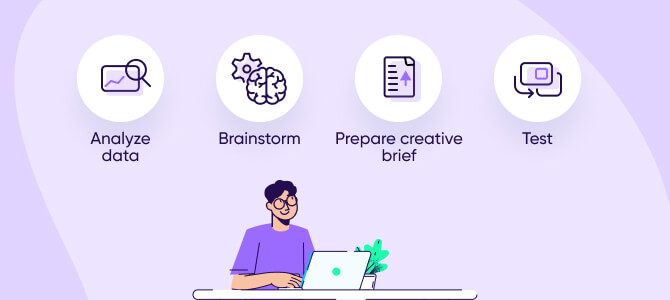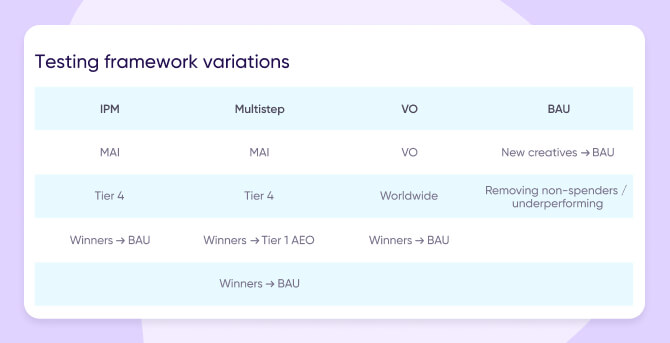
Why creative and top of funnel measurement is key in the privacy age and how to do it right

Mad Men or Math Men, which are more important in the post-IDFA (and post ATT) world?
Now more on than ever, the simple answer is both!
On the one hand, Math Men are needed to build models to make up for the loss of data signals — which requires quite a bit of heavy lifting. But on the other hand Mad Men are making a mega comeback as ad creative and upper funnel data is becoming key to mobile advertising success – in the absence of down-funnel signals.

As privacy concerns rise and data policies reflect these changes, app marketers will be forced to rely less on behavioral targeting and more on the design, experience, copy, and messaging of every ad.
Marketers need to make sure they are appearing in front of potential customers early in the consideration process in order to have a chance at conversion later on. This is why top of funnel measures like brand awareness and reach are becoming more important as behavioral data becomes more scarce.
The success of your ad campaigns will be measured by how your ad creatives perform in different environments.
How it works: then vs now
User Acquisition (UA) managers used to conduct A/B testing against multiple audiences in simple image and video formats. More often than not, they leveraged deterministic tracking to understand the full lifecycle of creatives and how well they drove installs relative to reach (IPM) or return on ad spend (ROAS).
With the App Tracking Transparency (ATT) framework, you’re left with basic dynamic reporting for each ad set, including CTR, spend, clicks, and impressions. Not to mention, multivariate-level reporting is limited due to postback delays.
How do you measure creative performance then?
With Apple and Google already speedily rolling out their privacy regulations, UA managers need to stay on top of what advertising features are released and deprecated, and not rely on hacking their way for short-term results.
It begins with understanding how SKAdNetwork (SKAN) works, but ultimately shifting the measurable KPIs. WIth contextual targeting, creative performance heavily relies on CTR, CPI, and engagement (comments, shares, and likes) instead of ROAS. An ad creative performing well indicates that you’re reaching the right audience, speaking the right message, and effectively engaging with your audience.
What are the measurement pitfalls?
Creative measurement isn’t going to get better with SKAN 4.0. Testing ad creatives will still not provide direct, audience data. You’ll rely on modeled conversions – aggregated and anonymized data to estimate conversions that perform on each platform – on the creative level.
Creative testing on iOS can also be misleading. Alternatively, marketers should apply learnings from A/B testing creatives on Android devices to universal campaigns.
UA managers ultimately need to adapt a creative framework that minimizes human error, but also focuses on deploying the best creative assets possible.
The creative framework in a post-IDFA world
The creative framework comes in multiple parts: analyze data, brainstorm, creative brief, test, and evaluate (and repeat for glory).
Let’s break down each one.

Step 1: Analyze your data
The very first step is to analyze your creatives and historical ad performance. If you don’t have any data to start with, conduct a competitor creative analysis. Find out what creatives your direct competitors are deploying on which UA channels.
Step 2: Brainstorm
These insights you unearth from your research will guide your creative brainstorming process.
“What I found was integral to my creative process is to bring game designers or product managers into the brainstorming sessions. Their unique perspective of the target audience was invaluable,” Lancaric noted.
Step 3: Prepare a creative brief
With all the creative concepts you’ve come up with your team, put them down onto paper in the form of a creative brief. Whether it’s structured like a storyboard, ensure your brief is clear about the core concept, its individual elements, and messaging.
Step 4: Test, test, test
Creative testing is best done on Facebook or TikTok, but can also be done on other channels as well. Look at the numbers in each respective dashboard and analyze why your winning creatives won. With those learnings, move the winning creative into your BAU (business as usual) campaigns.

There are other testing frameworks you can explore, and you have to find out which one works best for your unique needs. These include:
- Impression to Install Rate (IPM)
- Multistep
- Value Optimization (VO)
- Business as Usual (BAU)
According to Lancaric, “I’ve run A/B tests on both platforms before and found out that winning creatives on Android perform well on both iOS and Android and even across the UA channels.”
Step 5: Evaluate (and repeat for glory)
When a marketer runs an ad on Facebook with last-touch attribution and without an MMP, Facebook takes credit for 100% of the conversions. These results can be misleading because they include conversions that would have happened without being exposed to the Facebook ad in the first place. UA managers need to take a blended approach in measurement through incrementality tests.
It’s the additional (or incremental) conversions, beyond those that would have converted anyway, that represent the real contribution or impact of the ad. That’s incrementality – the conversions that were truly caused by the media in question.
Media mix modeling
Then there’s media mix modeling (MMM), also referred to as marketing mix modeling, which is an analysis technique that allows marketers to measure the impact of their marketing and advertising campaigns to determine how multiple elements ranging from consumer trends to external influencers, to create a holistically optimized campaign that will drive player engagement and ROI.
Predictive modeling
Measuring predictive lifetime value (pLTV) through predictive modeling enables you to make decisive decisions quickly by nipping unsuccessful campaigns in the bud, or doubling down on investment that can drive even better results — without compromising user privacy.

Measuring pLTV leverages data to predict how your audience will behave over a predefined period of time based on past behavior. To be more practical, you can apply the learnings from your winning Android creatives to your iOS campaigns by identifying early ROAS performance. Predictive modeling will identify creative performance insights much quicker and more accurately, which then you can use to optimize your campaigns across multiple channels.
Go and be creative
As privacy changes continue to transform the way app marketers run their campaigns, a sustainable strategy is rooted in a consistent, and iterative process.
Testing ad creatives and measuring them will become increasingly important, so ensure you are measuring and optimizing for CTR, CPI, and engagement.





